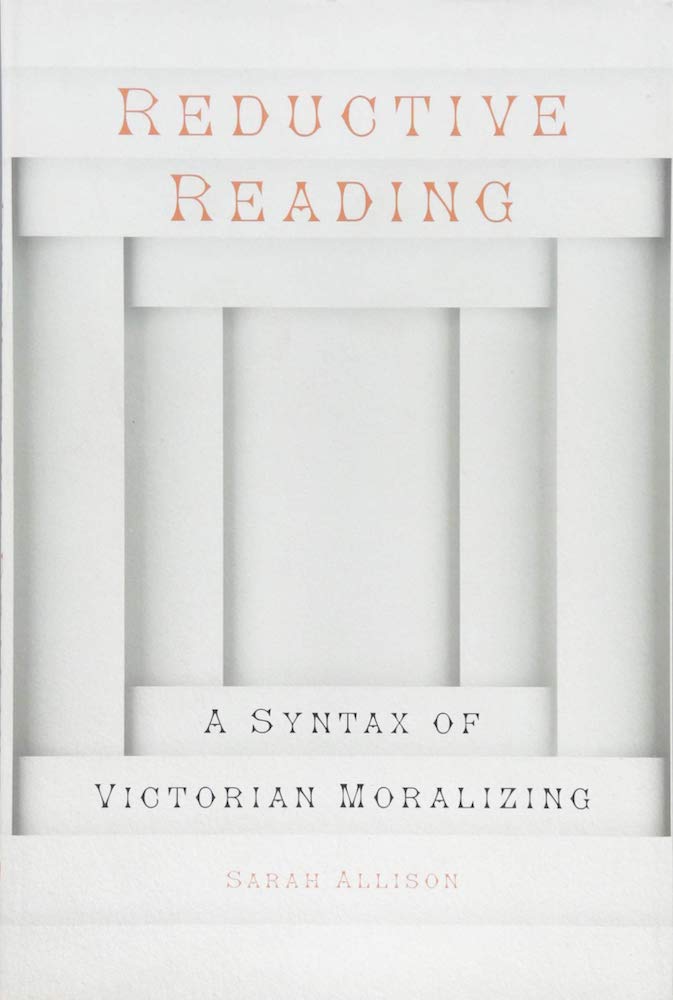Collations: Book Forum on Sarah Allison’s Reductive Reading: A Syntax of Victorian Moralizing
 The V21 Collations: Book Forum welcomes Paul Fyfe, Kate Holterhoff and Sheila Liming in conversation about Sarah Allison’s Reductive Reading: A Syntax of Victorian Moralizing (Hopkins, 2018). A masterful integration of digital humanistic approaches and more traditional close-reading methods, Reductive Reading makes a compelling, persuasive case for the way that the style of Victorian literature shaped morality. In constructing her argument, Allison demonstrates the way that a “reductive” approach to reading for particular syntactic patterns can productively blend approaches that many critics view as opposed. By working reductively, Allison means “reducing a body of texts to specific features” (1) that can be identified by computers and read closely by humans. Computing methods allows Allison to detect the dominant pattern, for example, of relative clauses, in George Eliot’s fiction (discussed in Chapter 3). Close reading allows her, then, to determine how this kind of sentence, appearing “about 130 times” in Middlemarch (61), “shifts from the narrative past tense to a universalizing present” that “models a process of seeing…[and] making judgments and [thus] aim to educate the reader in methods of assuming the perspective of other people” (61-62). As the most thoughtful accounts of digital humanistic methods insist, Reductive Reading demonstrates that counting does not have to be a substitute for (close) reading; instead, counting might allows us to see texts that we think we already know in entirely new ways, showing us patterns that our traditional close-reading practices might have initially overlooked.
The V21 Collations: Book Forum welcomes Paul Fyfe, Kate Holterhoff and Sheila Liming in conversation about Sarah Allison’s Reductive Reading: A Syntax of Victorian Moralizing (Hopkins, 2018). A masterful integration of digital humanistic approaches and more traditional close-reading methods, Reductive Reading makes a compelling, persuasive case for the way that the style of Victorian literature shaped morality. In constructing her argument, Allison demonstrates the way that a “reductive” approach to reading for particular syntactic patterns can productively blend approaches that many critics view as opposed. By working reductively, Allison means “reducing a body of texts to specific features” (1) that can be identified by computers and read closely by humans. Computing methods allows Allison to detect the dominant pattern, for example, of relative clauses, in George Eliot’s fiction (discussed in Chapter 3). Close reading allows her, then, to determine how this kind of sentence, appearing “about 130 times” in Middlemarch (61), “shifts from the narrative past tense to a universalizing present” that “models a process of seeing…[and] making judgments and [thus] aim to educate the reader in methods of assuming the perspective of other people” (61-62). As the most thoughtful accounts of digital humanistic methods insist, Reductive Reading demonstrates that counting does not have to be a substitute for (close) reading; instead, counting might allows us to see texts that we think we already know in entirely new ways, showing us patterns that our traditional close-reading practices might have initially overlooked.
In demonstrating the value of its method, Reductive Reading argues provocatively for scholars to be more self-conscious about their methods, offering the kind of “clear defense of…approach” that Allison offers upfront (11). The very form of her text, with two initial chapters that elaborate on the book’s critical methodology before turning to discussions of the London Quarterly Review, George Eliot, Elizabeth Barrett Browning and Charles Dickens, demonstrates the value of that defense. Allison wants to help us to see how reading reductively “for the intersection of style and morality that seemed obvious to many Victorian reviewers…is echoed by twentieth-century debates about style and politics” (5). She also, in the process, calls for a more thoughtful, honest and perhaps even productively defensive accounting for why and how we do scholarly work, as well as the ideal, indeed moral, outcomes of that work.
| Reflection by Paul Fyfe | Reflection by Kate Holterhoff | Reflection by Sheila Liming |
Maeve Adams, Convener and Co-Editor
Justin Raden, Co-Editor
There are no comments yet.